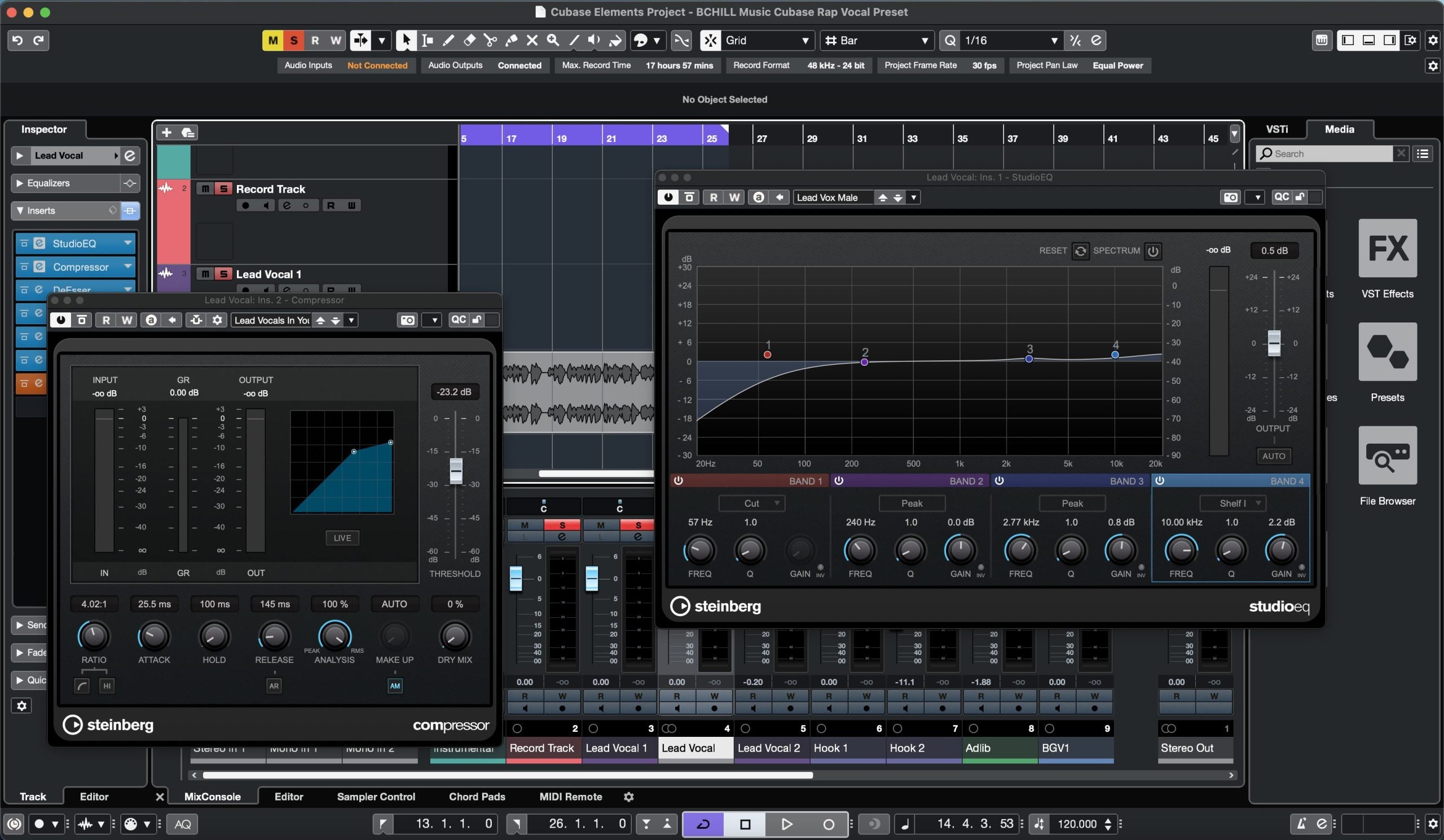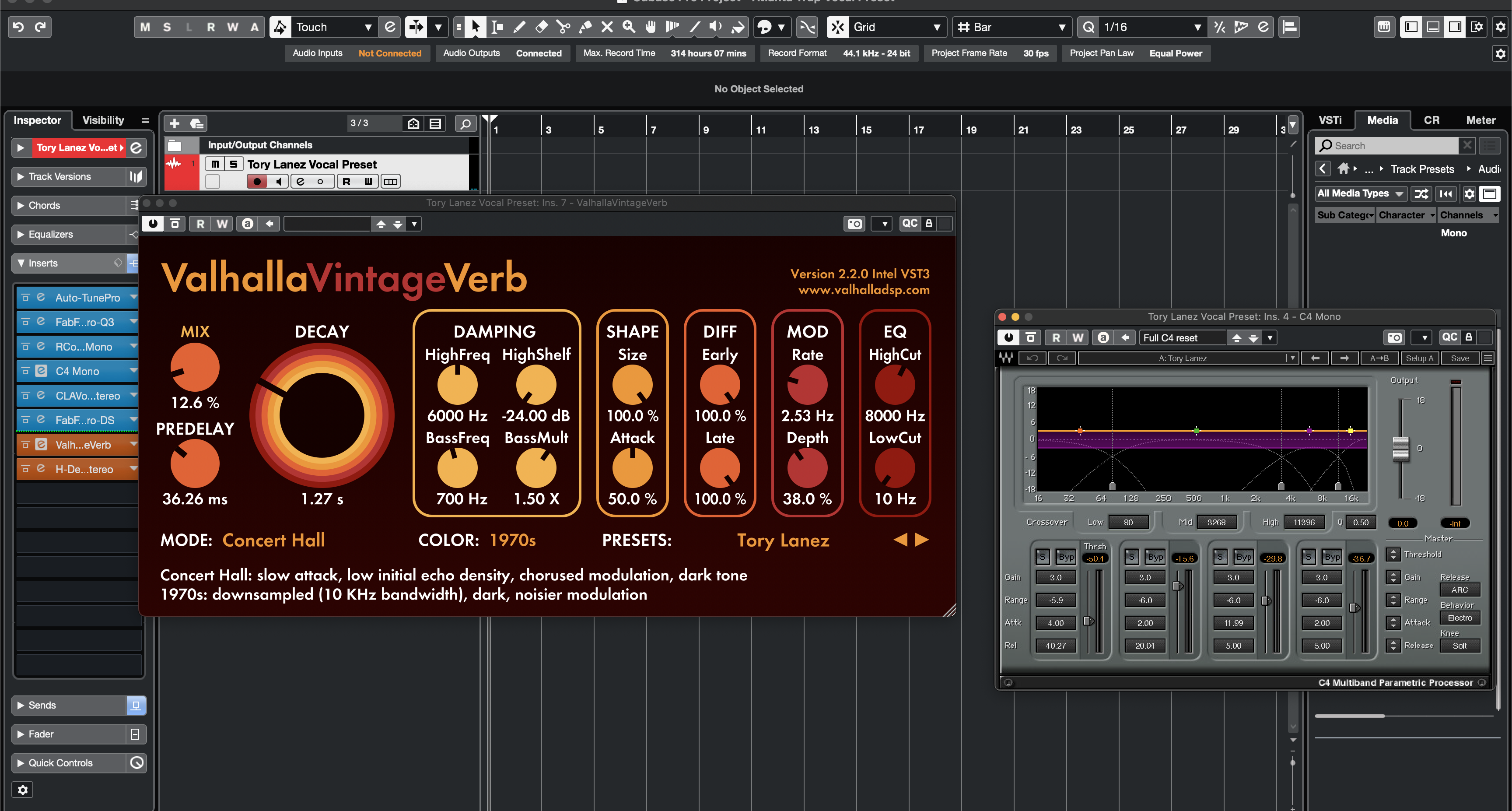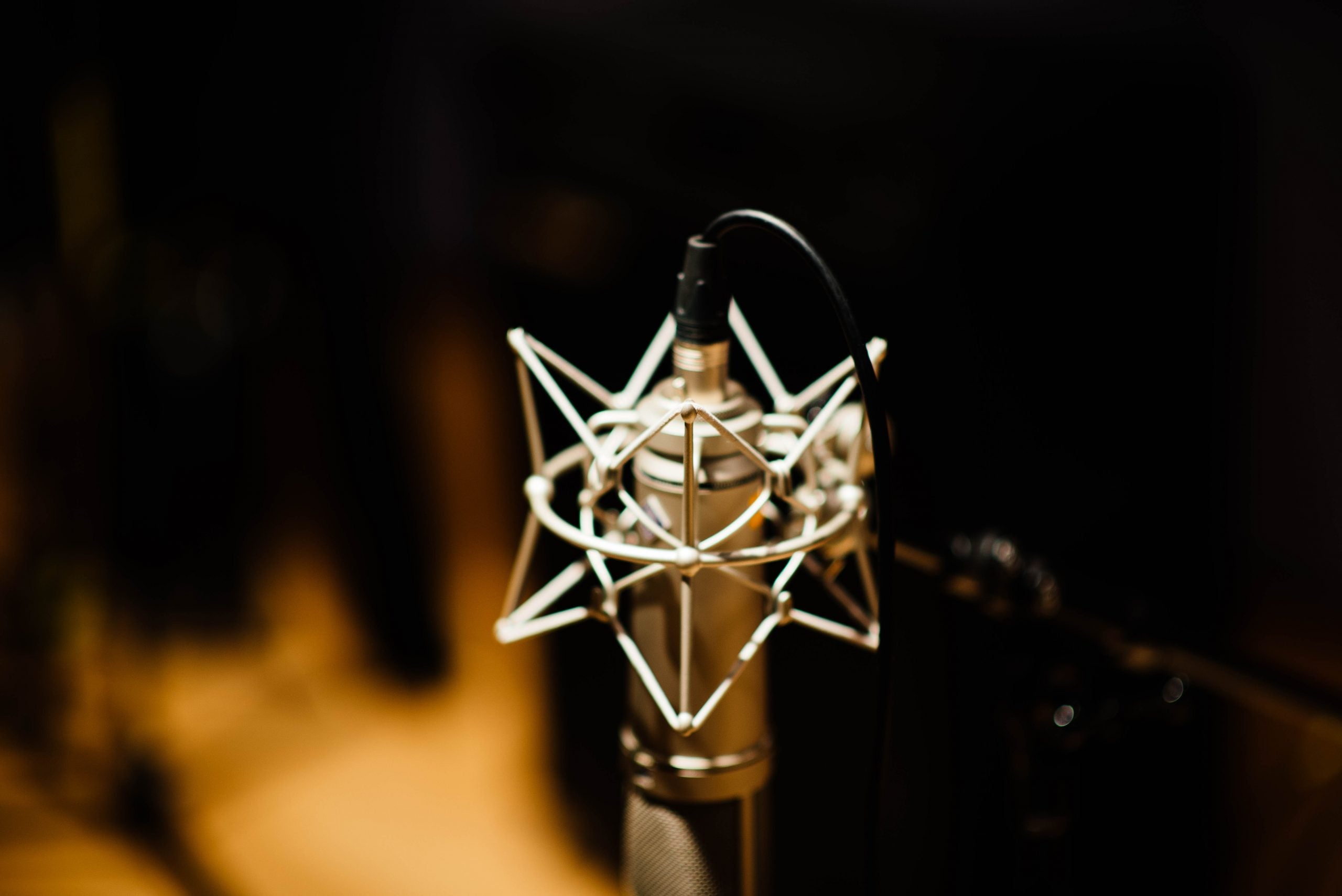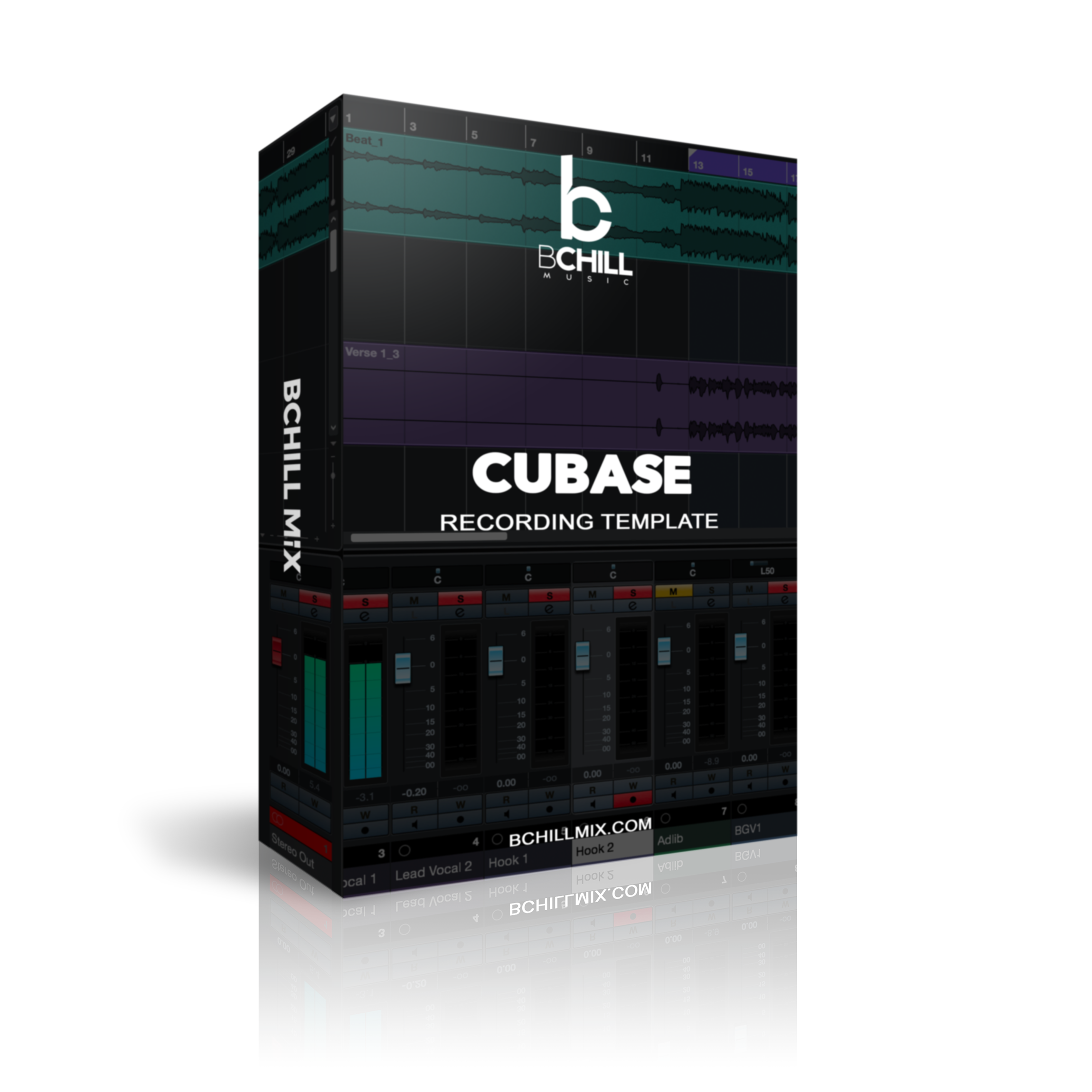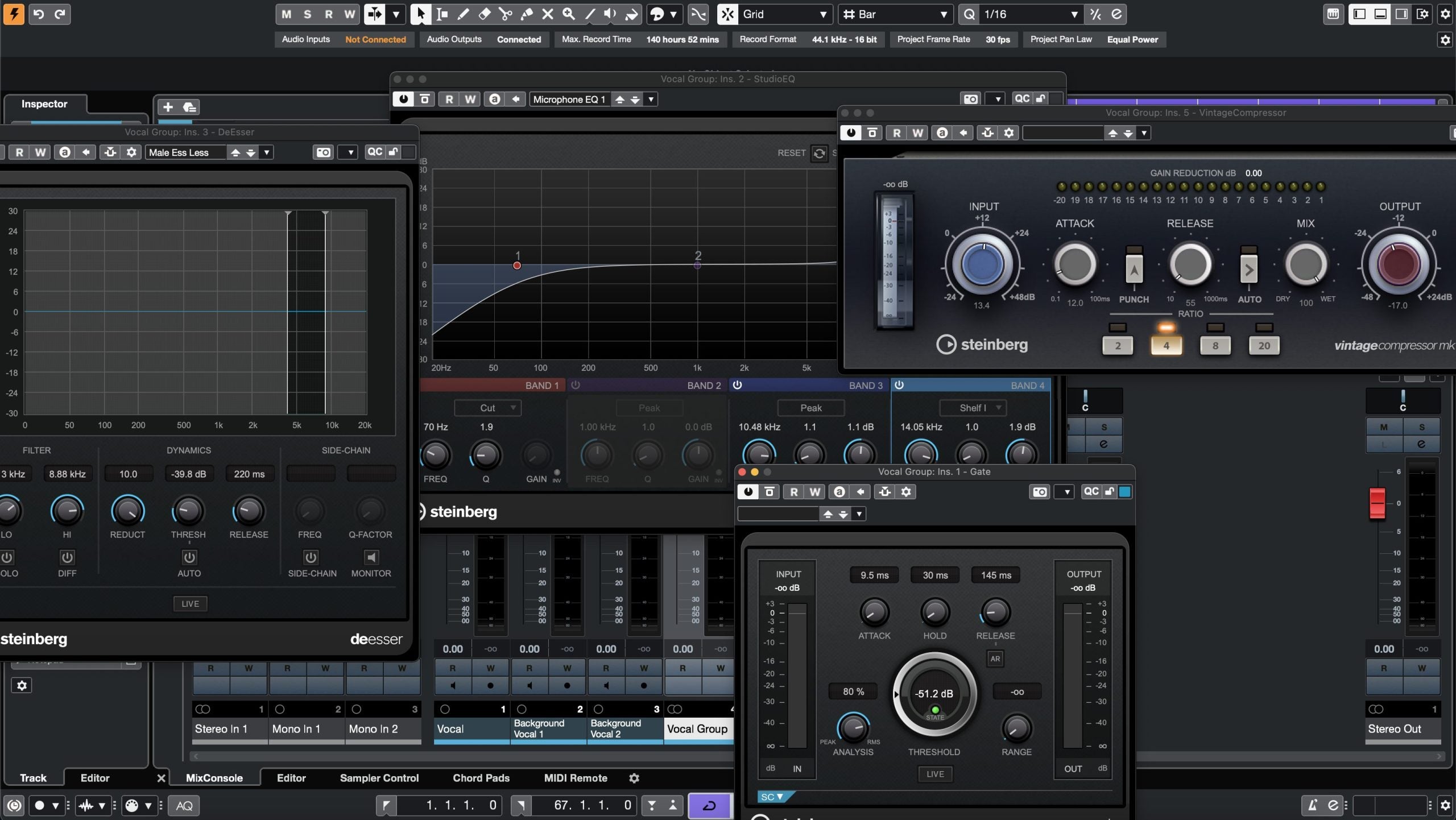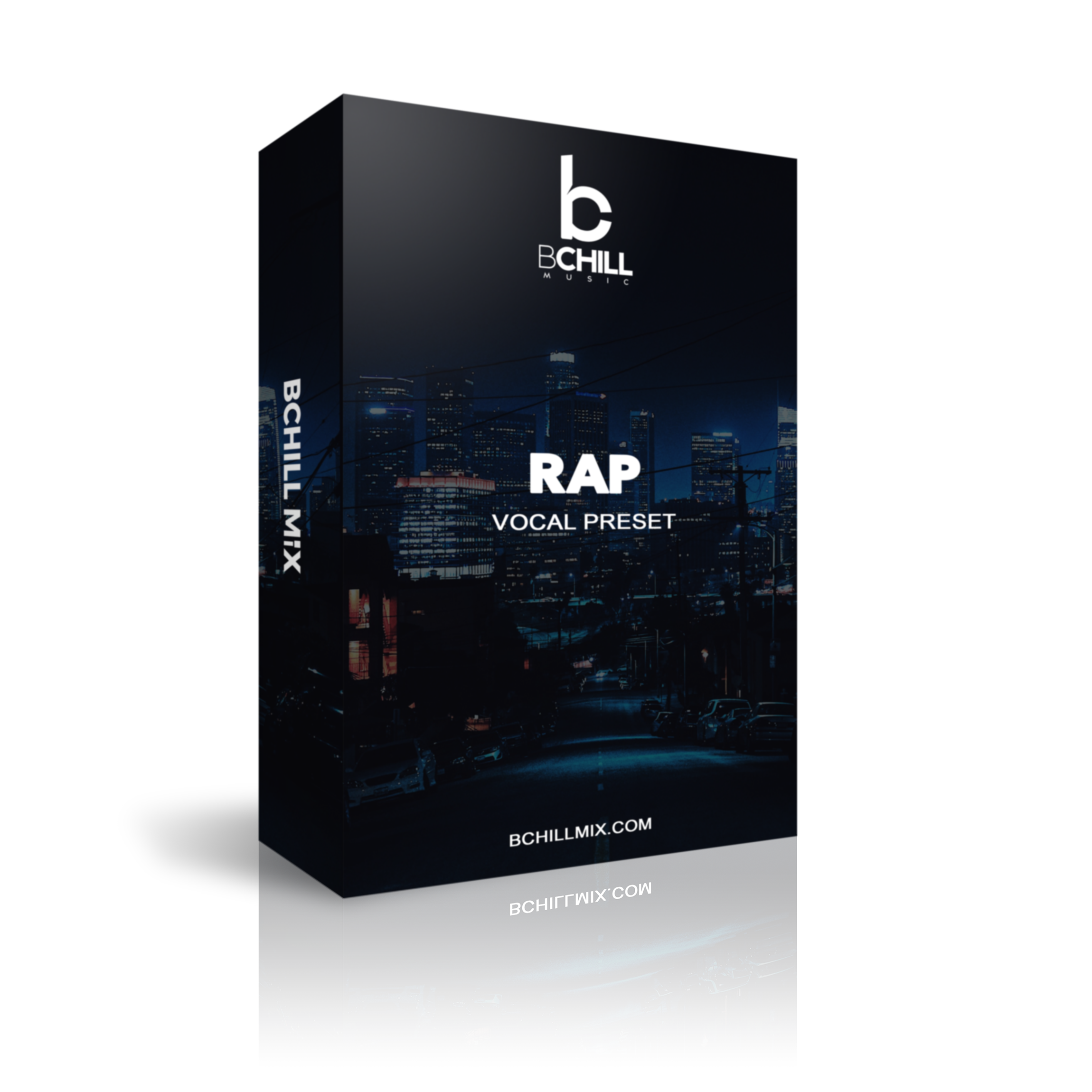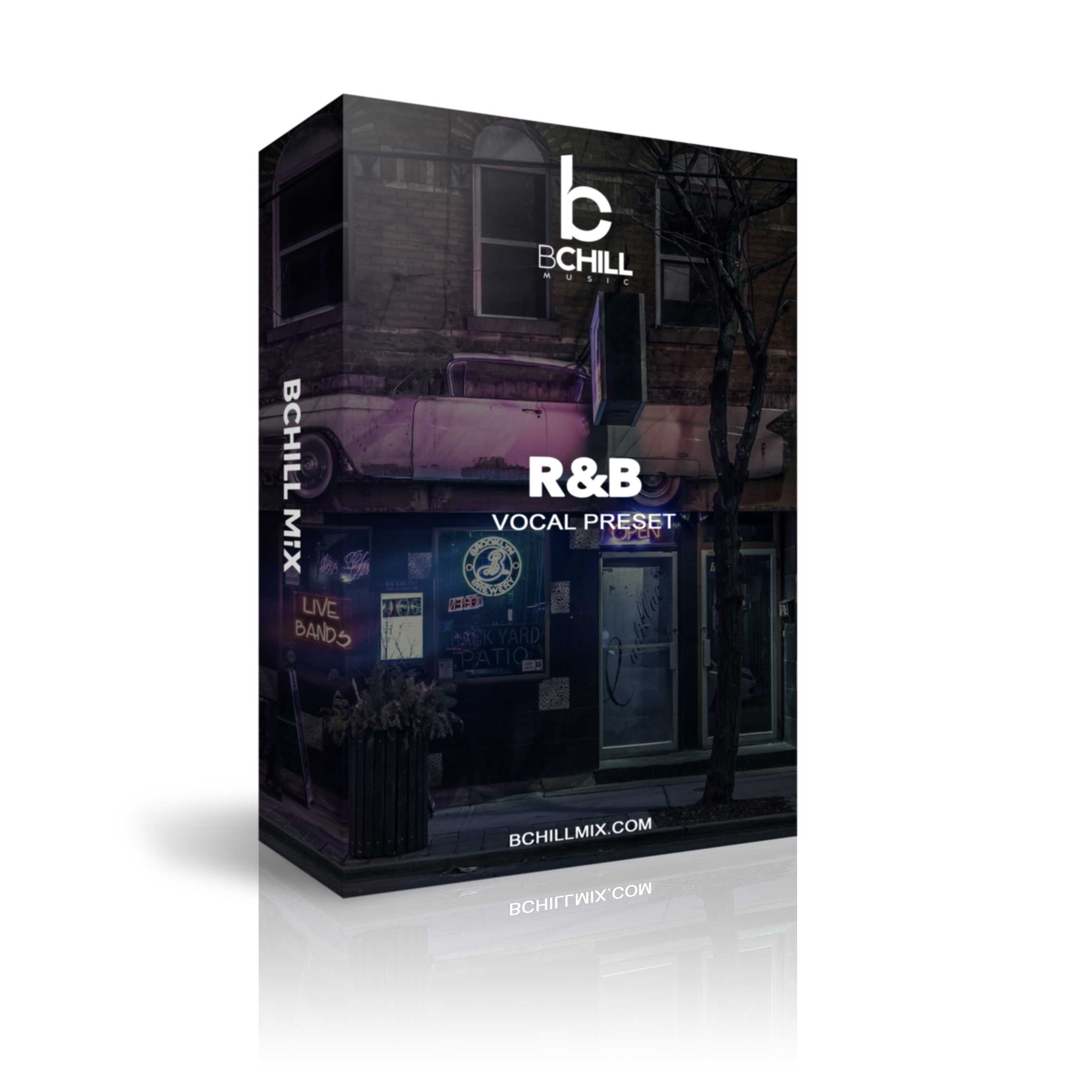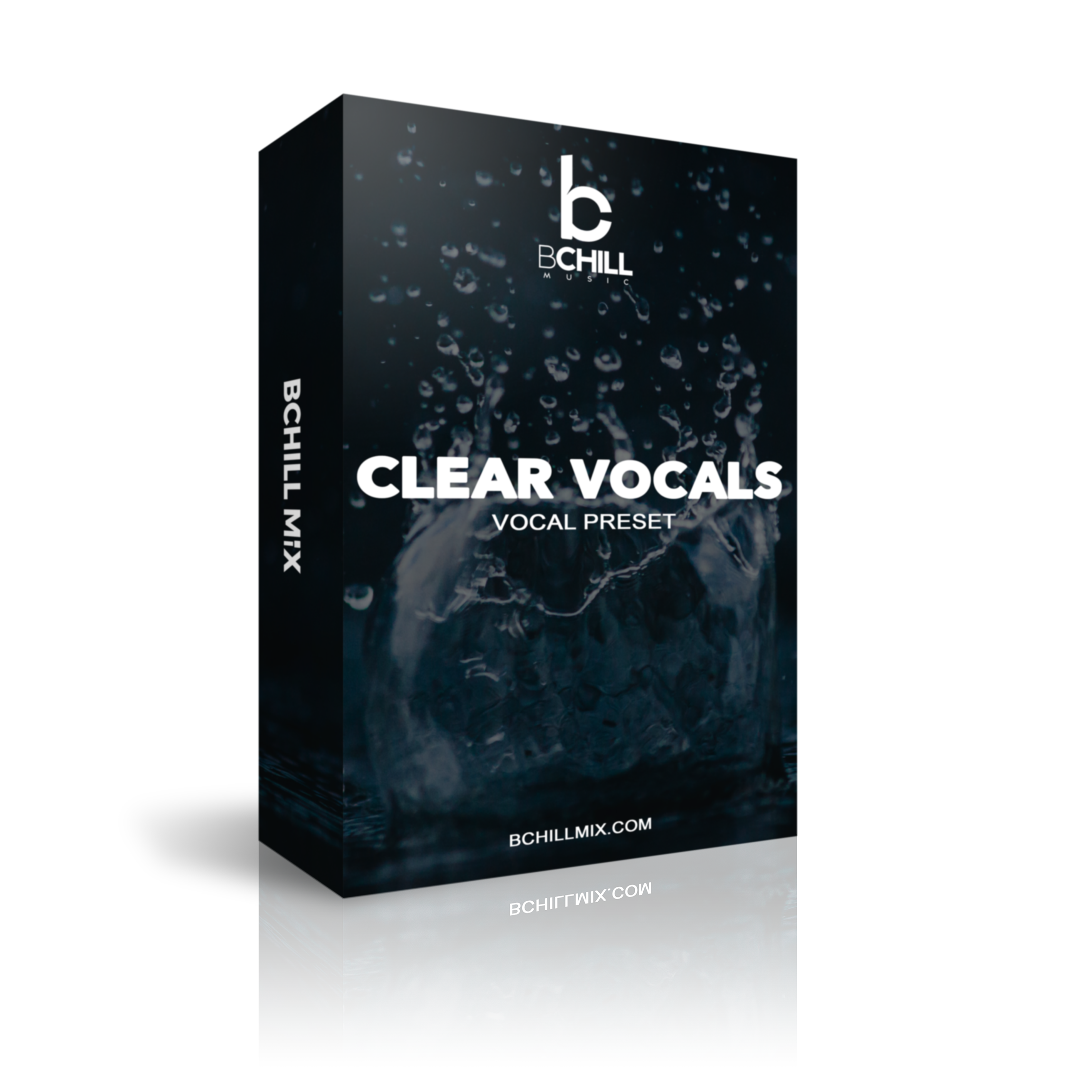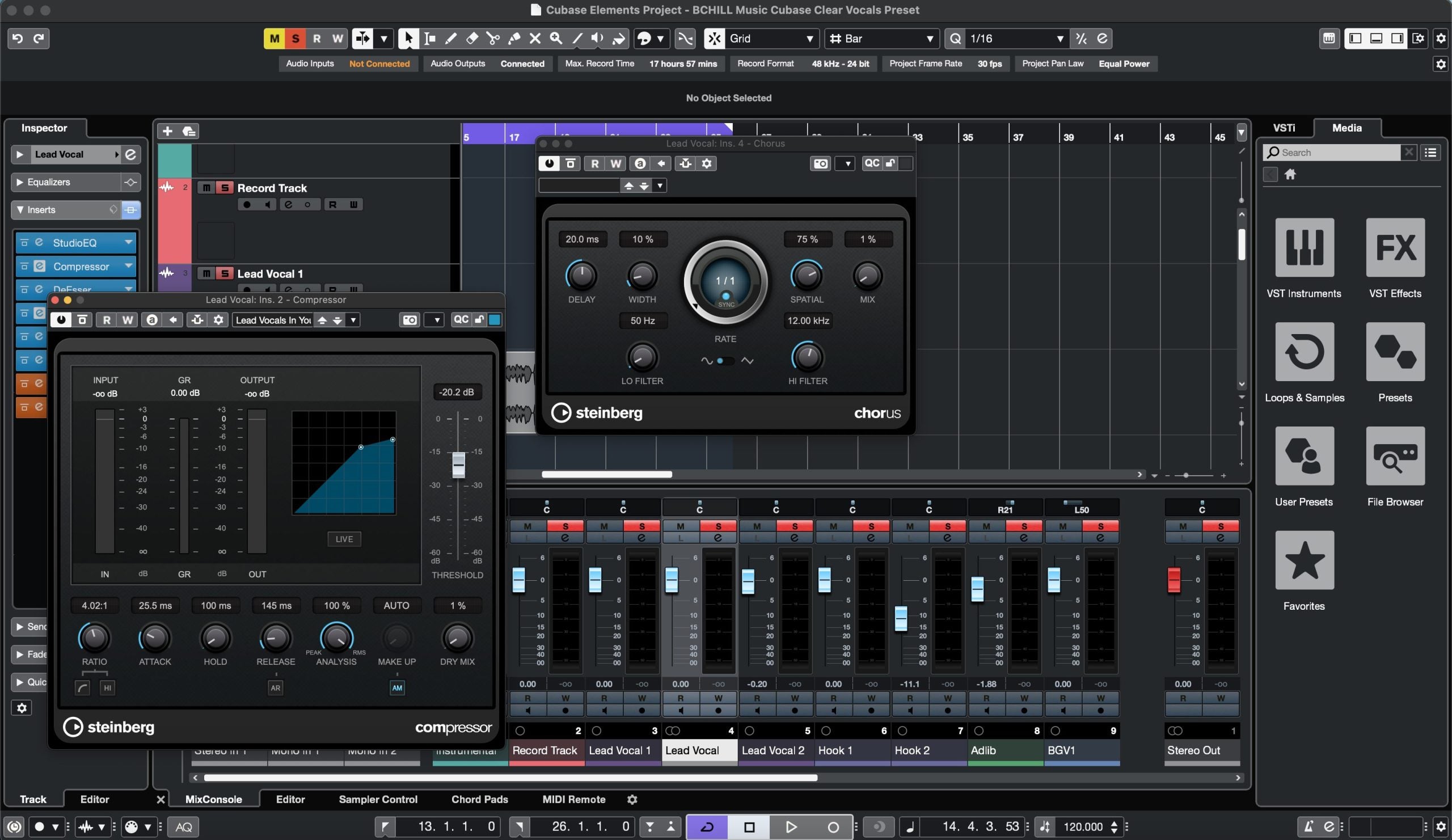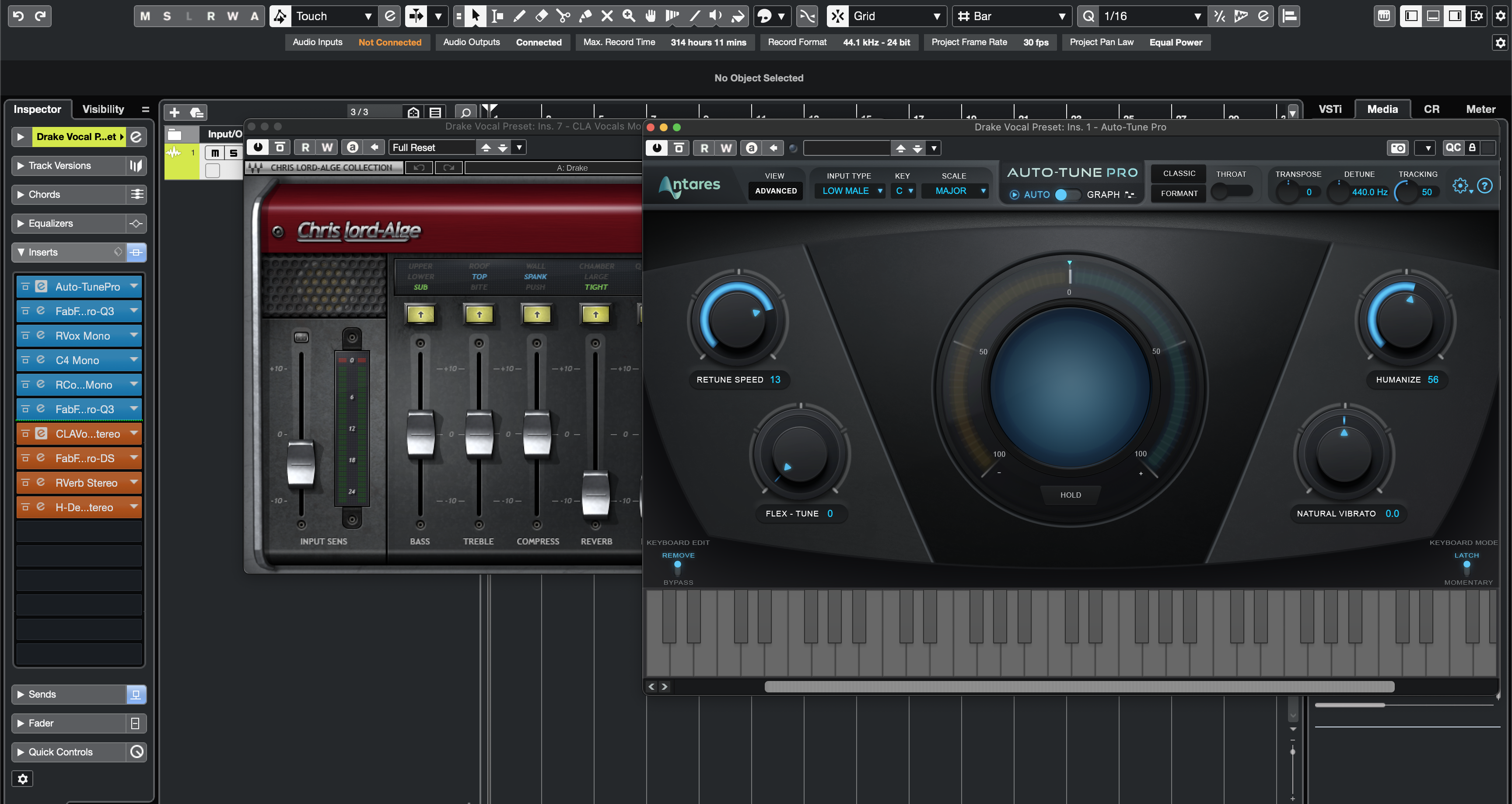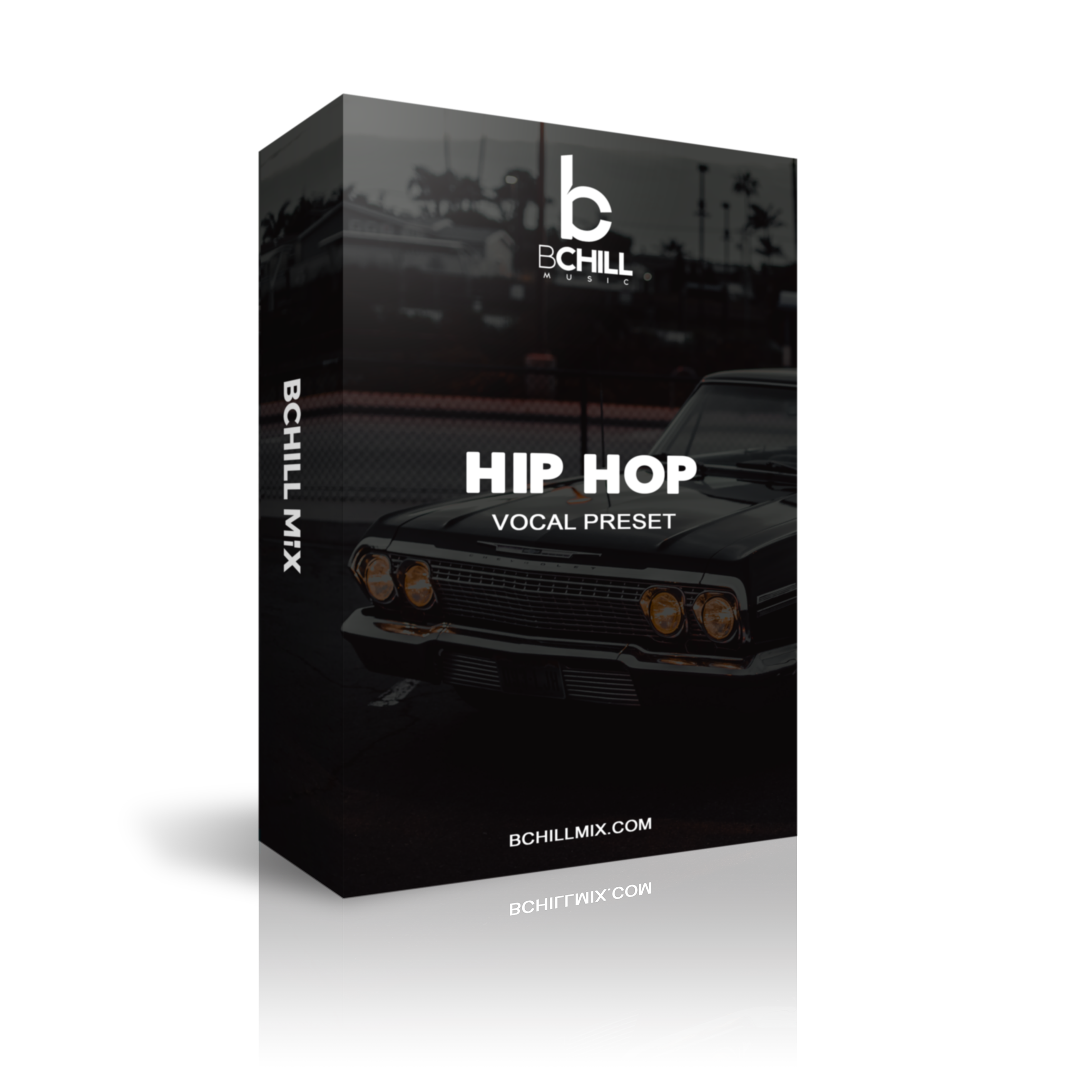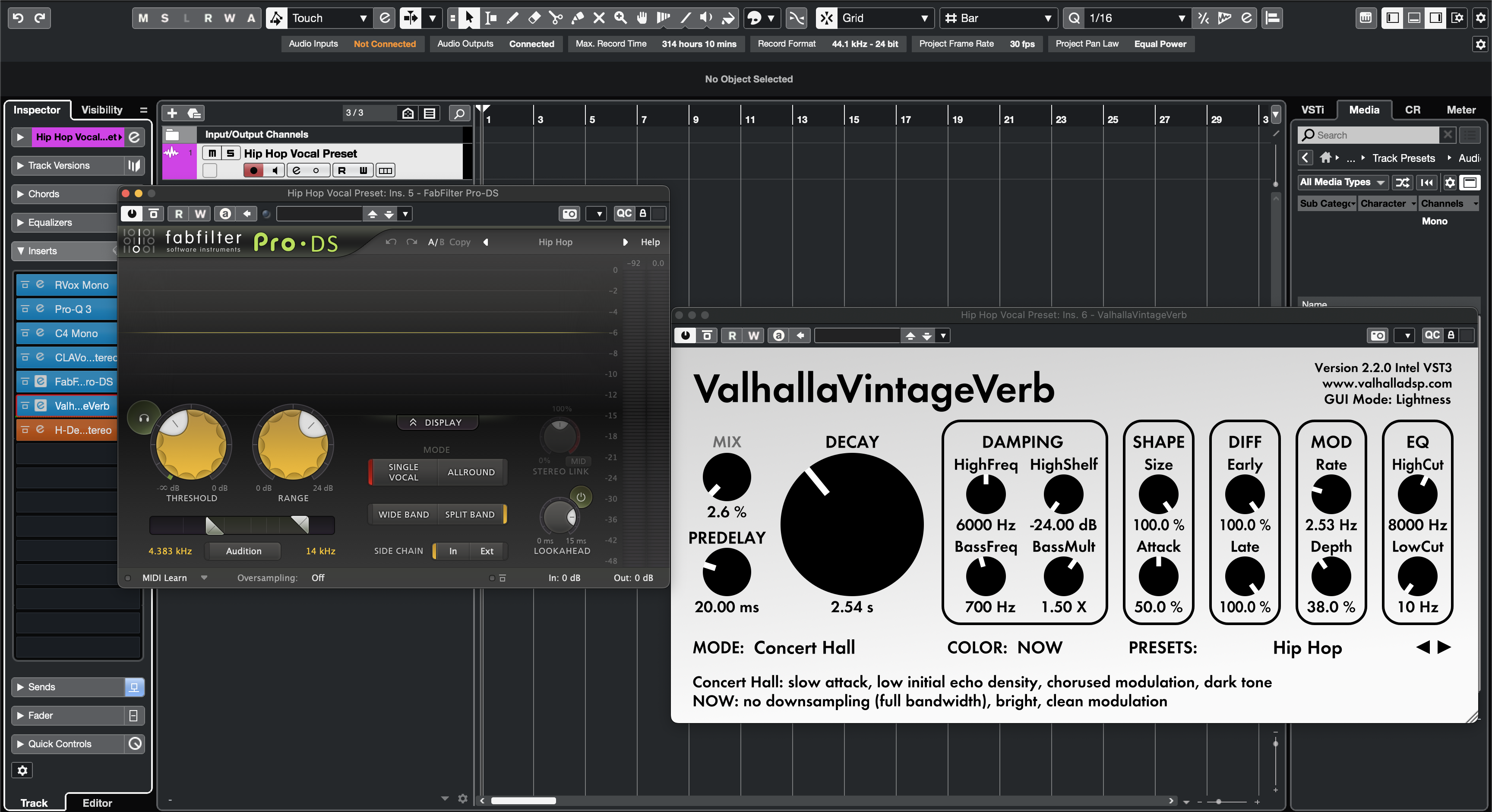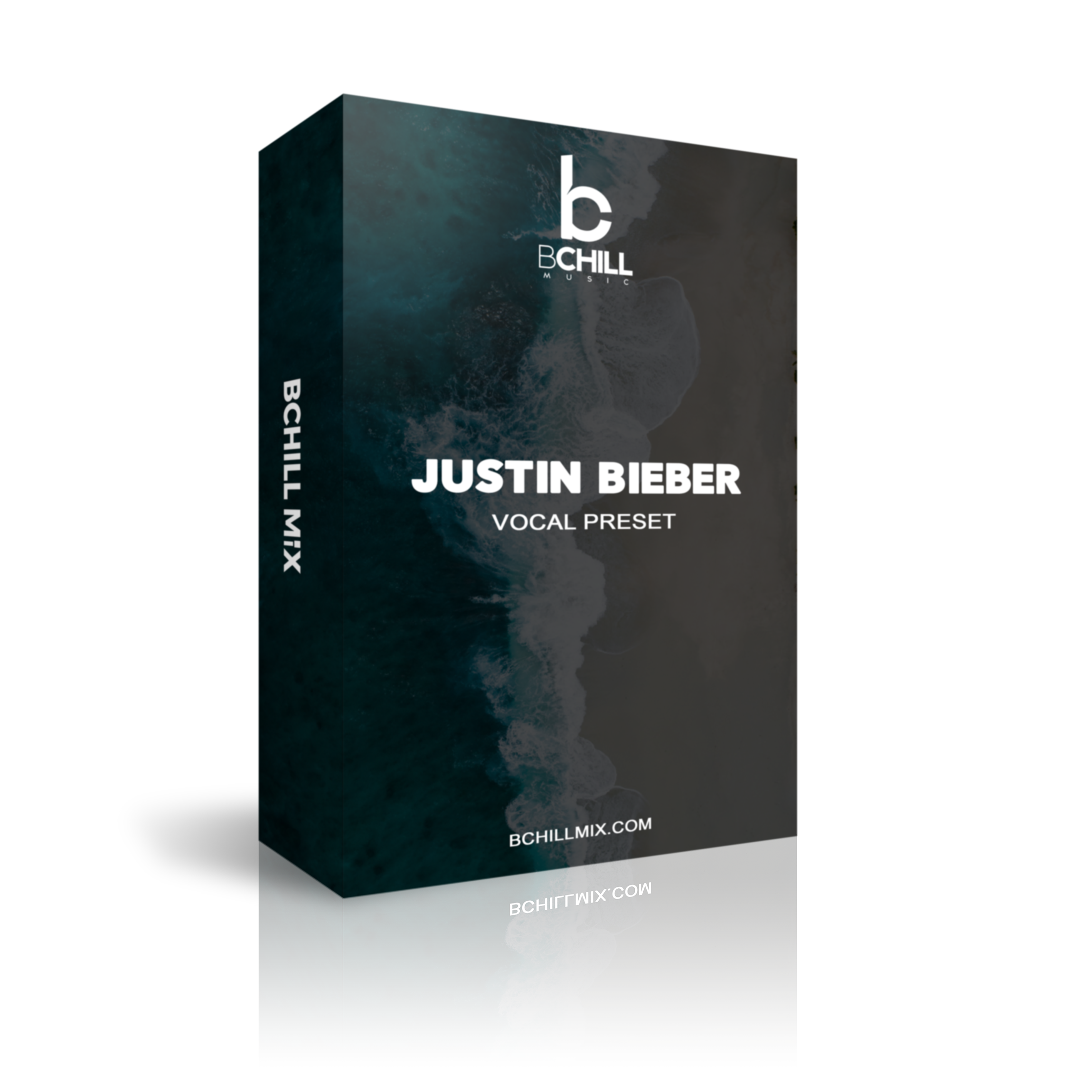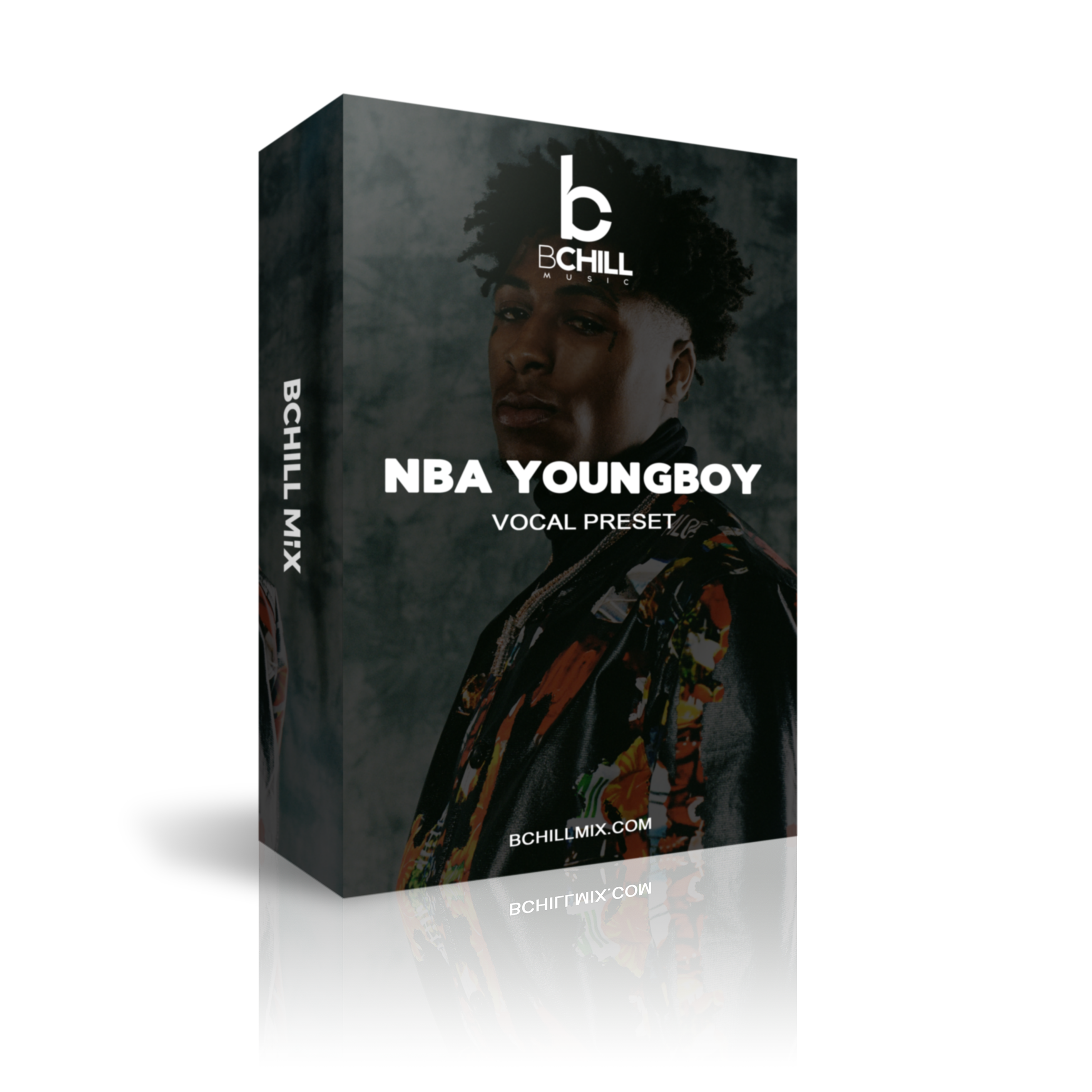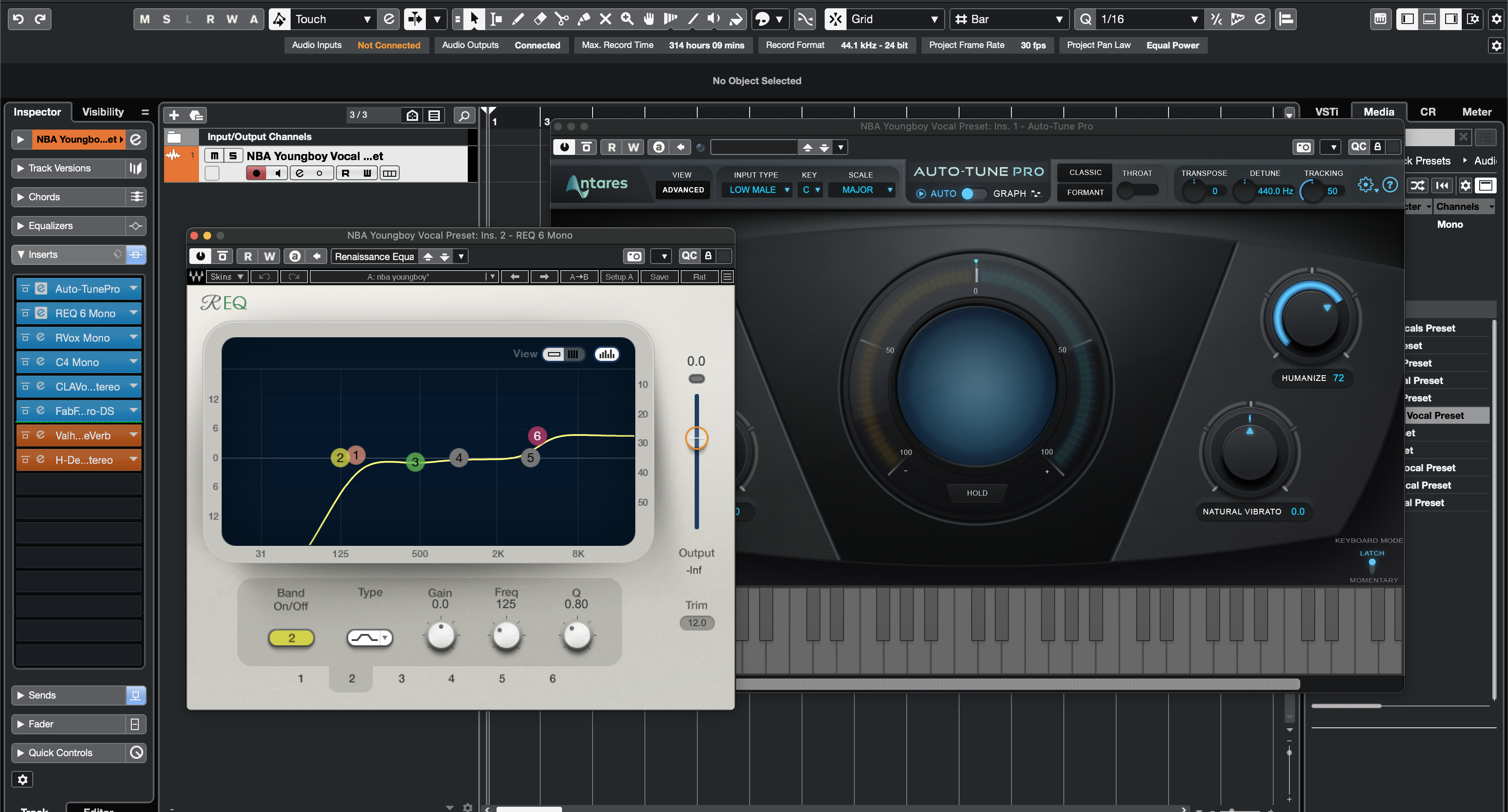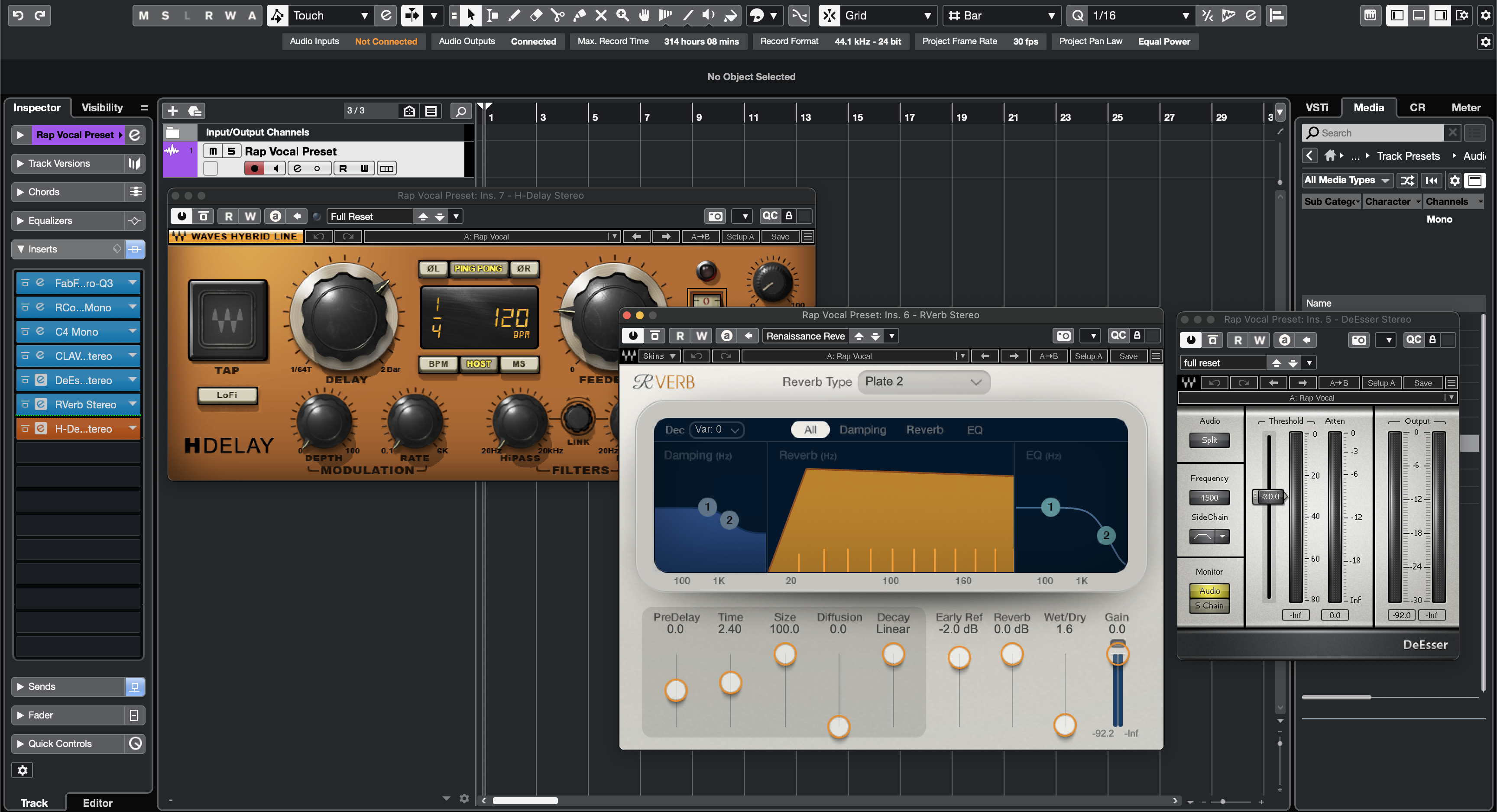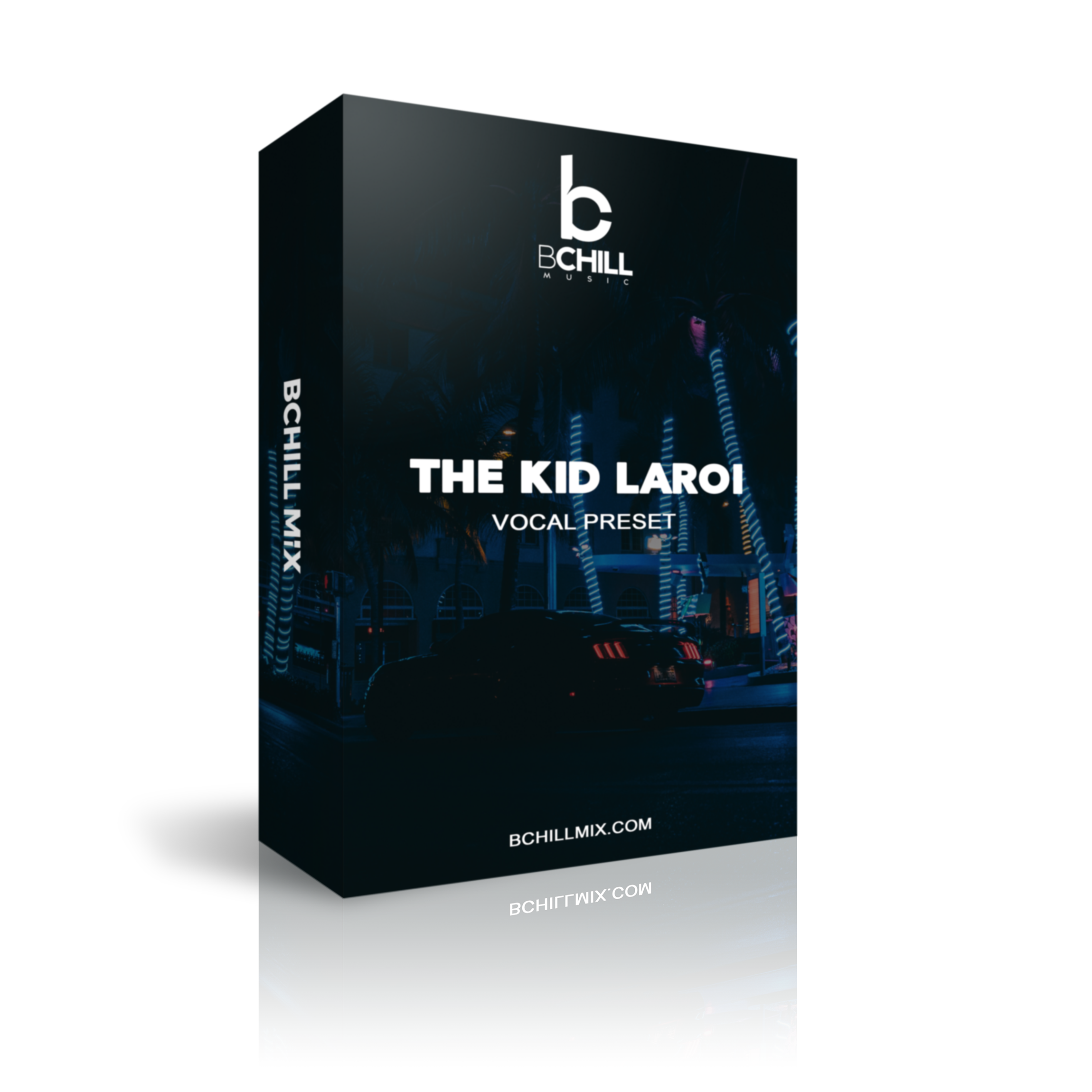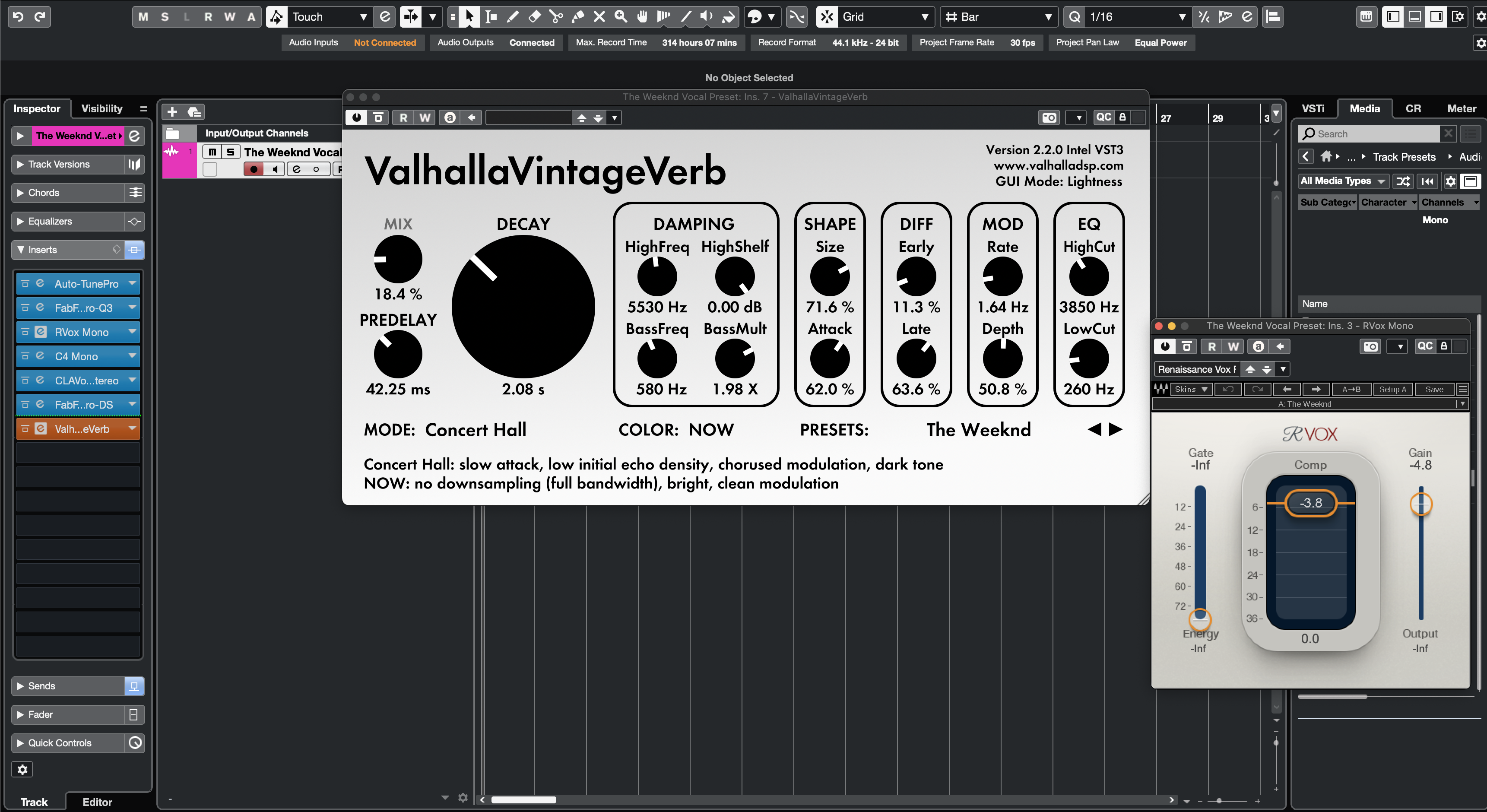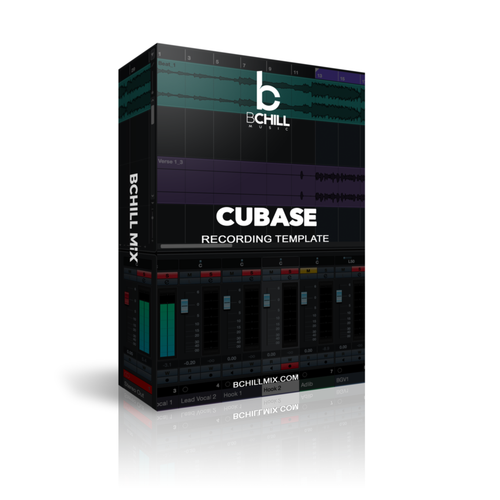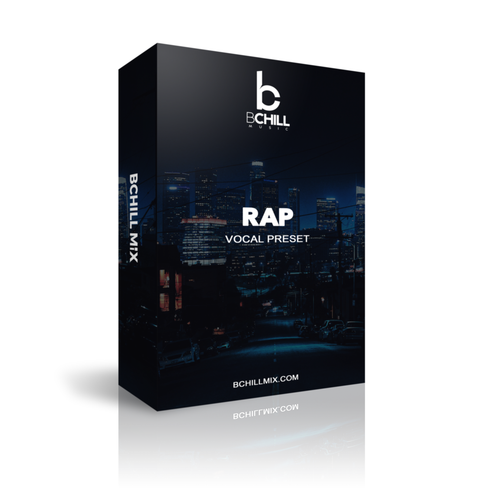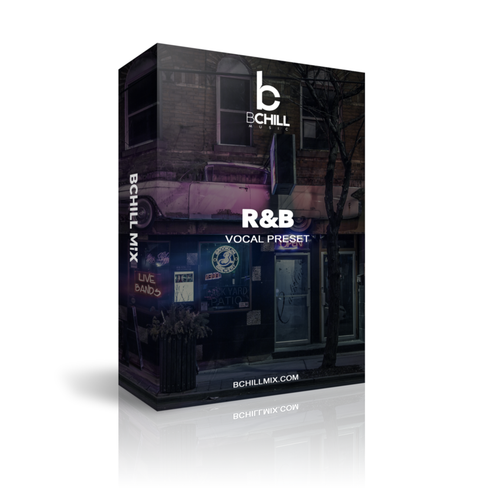Plantillas y Presets Vocales de Stock
Tipo: Plantilla de Grabación
Plantilla de grabación de Cubase (Plugins de stock)
Tipo: Preset Vocal
Preset de Vocal Rap para Cubase (Plugins de Stock)
Tipo: Preset Vocal
Preset Vocal R&B Cubase (Plugins de Stock)
Tipo: Preset Vocal
Preset de Voces Claras Cubase (Plugins de Stock)
Premium Presets Vocales
Tipo: Preset Vocal
Preset Vocal Trap de Atlanta para Cubase
Tipo: Preset Vocal
Preset Vocal de Drake para Cubase
Tipo: Preset Vocal
Preset Vocal de Hip Hop para Cubase
Tipo: Preset Vocal
Preset Vocal de Juice Wrld para Cubase
Tipo: Preset Vocal
Preset Vocal de Justin Bieber para Cubase
Tipo: Preset Vocal
Preset Vocal de Lil Baby para Cubase
Tipo: Preset Vocal
Preset Vocal de NBA YoungBoy para Cubase
Tipo: Preset Vocal
Preset de Voz Rap para Cubase
Tipo: Preset Vocal
El Preset Vocal de The Kid Laroi para Cubase
Tipo: Preset Vocal
Preset Vocal de The Weeknd para Cubase
Tipo: Preset Vocal
Preset Vocal de Tory Lanez para Cubase
Construye tu propia cesta
Transforma Tu Sesión En Segundos




Créditos de la Industria

Westside Boogie

Shontelle

Jarren Benton

DJ Tunez

Vory

Caskey

Rittz

Nia Riley

Eugy

Q Parker
Acerca del Ingeniero

Acerca del Ingeniero
¡Hola! Soy Byron Hill, un productor musical profesional e ingeniero de mezcla con más de 15 años de experiencia, basado en Atlanta, GA. He trabajado con miles de clientes en todo el mundo en una amplia gama de géneros, desde artistas independientes hasta talentos de grandes sellos. Mis créditos incluyen trabajo con Westside Boogie, Vory, Shontelle, DJ Tunez, Jarren Benton y Ritz, así como creadores y marcas como Daryl Mayes, SeanDoesMagic y Chubbies Clothing.
A lo largo de los años, he desarrollado un oído entrenado para crear cadenas vocales que ofrecen un sonido limpio, equilibrado y profesional, sin importar el género o DAW. Cada preset en esta colección está construido con el mismo objetivo: ayudarte a moverte más rápido, sonar mejor y dar vida a tu voz con claridad, confianza e intención.
Escucha nuestro Trabajo
R&B
Antes de
Después de
Rap
Antes de
Después de
Popular
Antes de
Después de
Alma
Antes de
Después de
Roca
Antes de
Después de
Latino
Antes de
Después de
Preguntas frecuentes
¿Son estos ajustes amigables para principiantes?
¿Son estos ajustes amigables para principiantes?
Sí — cada preajuste está optimizado para funcionar al instante. Solo arrastra, suelta y comienza a grabar. Ya sea que estés comenzando o ya grabando regularmente, estos preajustes te ayudan a estar listo para mezclar el sonido de inmediato.
¿Necesito algún complemento de terceros para usar estos ajustes preestablecidos?
¿Necesito algún complemento de terceros para usar estos ajustes preestablecidos?
Ofrecemos tanto versiones de plugin de stock (no se requieren plugins adicionales) como versiones premium (que utilizan herramientas de terceros estándar de la industria). La descripción del producto enumera claramente cualquier plugin requerido.
¿Funcionará esto con Cubase?
¿Funcionará esto con Cubase?
Sí — cada preajuste está construido específicamente para tu DAW. Simplemente selecciona tu software del menú de preajustes antes de la compra.
¿Puedo usar estos para cantar, rapear o ambos?
¿Puedo usar estos para cantar, rapear o ambos?
¿Qué tan rápido recibo mis archivos después de la compra?
¿Qué tan rápido recibo mis archivos después de la compra?
Explicación y características de los presets vocales de Cubase
I. Introducción a los Presets Vocales de Cubase
Si grabas o mezclas voces en Cubase, un preset vocal te ofrece un sonido confiable y repetible sin tener que reconstruir la misma cadena en cada sesión. Un preset carga una cadena vocal completa: EQ para dar forma al tono, compresión para el control, de-essing para suavizar los sonidos “s”, y una ambientación de buen gusto, para que puedas capturar ideas rápidamente y mantener tu tono consistente desde la demo hasta el lanzamiento. En BCHILL MIX, cada preset y plantilla de Cubase está ajustado para claridad, dinámica controlada y traducción en auriculares, monitores y teléfonos.
Puedes usar presets para rap, R&B, pop, trap melódico o voz hablada. Esta guía explica qué son los presets vocales de Cubase, cuándo ayudan, cómo instalarlos y ajustarlos, y cómo los presets vocales de Cubase y la plantilla de grabación de Cubase se complementan para un flujo de trabajo más rápido y organizado.
II. ¿Qué Son los Presets Vocales en Cubase?
En Cubase, un preset vocal es una cadena FX guardada o un Preset de Pista que aplica un orden conocido de procesadores con configuraciones iniciales sensatas. Una cadena equilibrada a menudo incluye:
- Un filtro pasa-altos suave y pequeños movimientos de EQ quirúrgicos para eliminar el ruido de fondo y domar la dureza.
- Uno o dos compresores en serie para suavizar frases fuertes/suaves sin bombeo.
- Un de-esser colocado antes del realce final para que la sibilancia se mantenga suave.
- Saturación opcional o excitador para presencia.
- Retraso sincronizado con el tempo y una reverb de placa o sala corta para espacio.
Puedes construir cadenas con Inserts y los módulos integrados de Channel Strip, luego guardarlas como presets para reutilizarlas en Lead, Doubles, Harmonies o un bus vocal. El objetivo es un control de ganancia predecible y un tono vocal limpio y moderno que puedas refinar rápidamente en lugar de reinventarlo en cada sesión.
III. ¿Por Qué Usar Presets (Beneficios y Cuándo Ayudan)
- Velocidad: Salta la configuración repetitiva. Abre un proyecto, elige tu preset y graba mientras la inspiración está fresca.
- Consistencia: Una cadena calibrada mantiene el tono alineado a través de canciones y sesiones—útil para sencillos, EPs y series de contenido.
- Enfoque: Con la “plomería” técnica manejada, puedes dedicar tiempo a la interpretación, dobles/ad-libs y arreglos.
- Traducción: Una buena cadena se mantiene inteligible en auriculares y teléfonos, así como en monitores de rango completo, por lo que las mezclas en bruto viajan bien.
- Baja fricción: Menos elecciones en el momento—especialmente útil al grabar en una laptop o en un horario ajustado.
Cuando ayudan más: sesiones de escritura rápidas; colaboración remota; creación de contenido (cortos/reels); mantener un sonido consistente a través de una serie; y cualquier flujo de trabajo donde quieras pasar de la idea a la toma en minutos.
IV. Enfoques de Stock vs. Premium en Cubase
Cadenas de Stock utilizan los procesadores nativos de Cubase (Channel Strip, EQ/Compresor/De-Esser de stock, Reverence/RoomWorks, etc.). Se cargan en cualquier sistema que ejecute Cubase—sin licencias de terceros—y son ideales si colaboras o te mueves entre máquinas. Las cadenas de stock son ligeras en CPU y eliminan problemas de “plugin faltante” en una computadora diferente.
Cadenas Premium añaden herramientas de terceros para un control más fino o un color específico (por ejemplo, compresores de carácter, saturadores especiales o corrección de tono avanzada). Estas pueden sonar geniales, pero requieren que los plugins listados estén instalados y activados en la máquina que abre la sesión.
¿Cuál deberías elegir? Si la portabilidad y la simplicidad son lo más importante, comienza con stock. Si tu equipo ya incluye plugins de terceros y deseas más opciones de modelado de tono, premium puede ser una opción perfecta. Muchos artistas mantienen ambos: una cadena de stock para grabar en cualquier lugar y una cadena premium para pulir en casa o en el estudio. Cualquiera que sea el camino que elijas, mantén la ganancia consistente para que los presets se comporten de manera predecible a través de proyectos.
V. Instalar y Comenzar Rápido (Paso a Paso)
- Crea y organiza. Comienza un nuevo proyecto. Agrega pistas para Lead, Doubles, Harmonies y Ad-libs. Códifícalas por color y establece salidas a un Vocal Bus para control agrupado.
- Configura la entrada y el buffer. Elige tu entrada de micrófono en la pista Lead. Graba una breve frase de prueba y ajusta la ganancia del preamplificador/interfaz para que los picos alcancen aproximadamente −10 a −6 dBFS. Para grabar, usa un buffer ASIO/CoreAudio más pequeño para menor latencia; para mezclar, aumentalo para estabilidad. Consulta la guía de buffer/latencia de Steinberg aquí.
- Carga la cadena. Abre Inserts/Channel Strip en tu pista vocal. Carga el preset (Preset de Pista o .vstpreset) o inserta procesadores en este orden: EQ → Compresor 1 (suave) → De-Esser → Compresor 2 (rápido/limpio) → saturación opcional → envíos a Reverb/Retraso.
- Dial umbrales y envíos. Baja los umbrales del compresor hasta que las líneas más fuertes se reduzcan unos dB sin bombeo. Ajusta el de-ess para que las consonantes sean suaves, no apagadas. Agrega ambientación con envíos; mantén los inserts mayormente secos mientras grabas para claridad y baja latencia.
- Guarda tu configuración. Guarda un Preset de Pista para tu voz y guarda una Plantilla de Proyecto para que cada sesión se abra con el mismo margen, enrutamiento y colores. ¿Prefieres un diseño listo para usar? Prueba la Plantilla de Grabación de Cubase (Stock).
Opcional pero poderoso: configura el Control Room para monitoreo/cues precisos, usa Audio Alignment para ajustar dobles/harmonías, y usa VariAudio para trabajo de tono donde esté disponible.
VI. Estilos y Casos de Uso (Rap, R&B, Pop, Claro/Pódcast)
Voz principal de rap (impacto + claridad). Usa dos compresores más ligeros en serie para control sin matar transitorios. Enfoca la inteligibilidad alrededor de 2–5 kHz con EQ cuidadoso, y agrega un slap corto o una pequeña placa para energía sin encharcamiento. Mantén los ganchos más amplios automatizando un poco más de envío de retraso en las líneas del coro. Si tu entrega es muy centrada, prueba un duplicador sutil para ancho en los ganchos.
Trap melódico / drill. Mantén el extremo superior brillante pero suave. Un toque de saturación antes del de-ess agrega mordida; síguelo con de-ess para que las consonantes no se vuelvan espumosas. Capa los ad-libs con un filtro pasa-altos ligeramente más alto y un toque más de de-ess para mantener las capas ordenadas. Para resultados rápidos, comienza desde una cadena de estilo de artista (por ejemplo, Preset Vocal de Trap de Atlanta o Preset Vocal de NBA YoungBoy) y ajusta envíos/umbrales para tu voz.
R&B / soul (canto suave). Apunta a un tono sedoso y calidez controlada en los medios bajos. Usa ataques/liberaciones más suaves, un estante de “aire” suave y una ambientación más amplia para profundidad. Un pre-retardo más largo agrega espacio sin enmascarar palabras. En los fondos, usa retrasos ampliados en estéreo y pasa-altos para prevenir niebla en los medios bajos. Si tu micrófono es brillante, corta un poco de dureza antes de la compresión para que no reaccione en exceso.
Pop. El pop moderno se beneficia de elevación y pulido. Agrega un estante alto de buen gusto y mantén la sibilancia bajo control con de-ess. Usa retrasos sincronizados con el tempo para amplitud; una reverb de sala muy corta puede “pegar” la voz sin sonar húmeda. Compara elecciones a un volumen igual—“más fuerte” a menudo suena “mejor”, así que iguala el nivel antes de decidir. En arreglos densos, esculpe 2–4 kHz con cuidado para que las palabras se mantengan inteligibles.
Voces claras / pódcast / hablando. Prioriza la inteligibilidad y el control de ruido. Usa compresión transparente, de-ess moderado y solo un toque de ambientación corta si lo seco se siente antinatural. La técnica supera el procesamiento: una distancia de micrófono consistente, un filtro anti-pop y una habitación tranquila superarán a los plugins pesados. Si grabas en un espacio animado, prueba un desruido/desreverb suave antes de EQ y compresión.
Respaldos, dobles, ad-libs. Una compresión ligeramente más ajustada y un toque más de de-ess ayudan a que las capas se mantengan sin desorden. Aumenta un filtro pasa-altos más alto en las capas para eliminar el ruido de fondo y la niebla en los medios bajos. Una ambientación más amplia o larga separa los fondos de la voz principal sin enmascarar palabras. Para ajustar el tiempo entre las capas, usa Audio Alignment de Cubase donde esté disponible.
VII. Plantillas de Grabación vs. Presets (Flujo de Trabajo)
Los presets vocales dan forma al tono y la dinámica en una sola pista o bus vocal. Las plantillas de grabación proporcionan el diseño completo de la sesión—pistas pre-nombradas (Lead, Doubles, Harmonies, Ad-libs), codificación por colores, enrutamiento, mezclas de cues y envíos listos—para que puedas pasar de la idea a la toma con una configuración mínima. Muchos creadores utilizan ambos:
- Una plantilla simple para que cada proyecto se abra organizado y calibrado, y
- Un pequeño conjunto de presets—Brillante, Neutro, Suave—para que cada nueva canción comience con el tono más cercano.
Si te mueves entre laptops o estudios, guarda presets en tu biblioteca de usuario para que la misma cadena viaje contigo. Para mezclas más profundas, prueba un flujo de trabajo de bus: coloca el procesamiento correctivo en la pista (EQ/Comp/De-ess) y el pulido creativo en un bus vocal (excitador, compresión de pegado, FX basados en tiempo). Eso mantiene la pista principal limpia y te permite elevar los coros ajustando algunos controles de bus en lugar de cada insert.
Explora herramientas relacionadas en BCHILL MIX: la Plantilla de Grabación de Cubase (Stock), cadenas inspiradas en géneros/artistas como el Preset Vocal de Rap para Cubase o navega por la colección completa de Presets Vocales de Cubase.
Última actualización: agosto de 2025 · Autor: Byron Hill (BCHILL MIX)
Dentro del DAW: Configuraciones de Presets Vocales de Cubase (Capturas de Pantalla)
Vea cómo se carga nuestra cadena vocal de Cubase en pistas de Lead y Bus. Estas capturas de pantalla muestran configuraciones iniciales para rap, R&B y pop, además de consejos rápidos para dobles/arreglos con Alineación de Audio y VariAudio.

